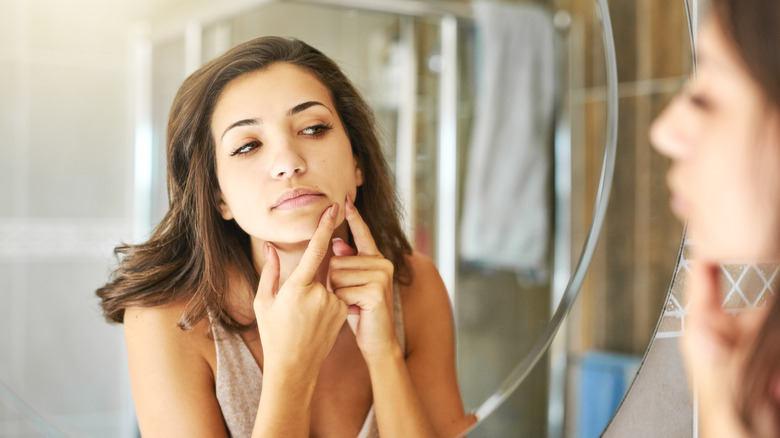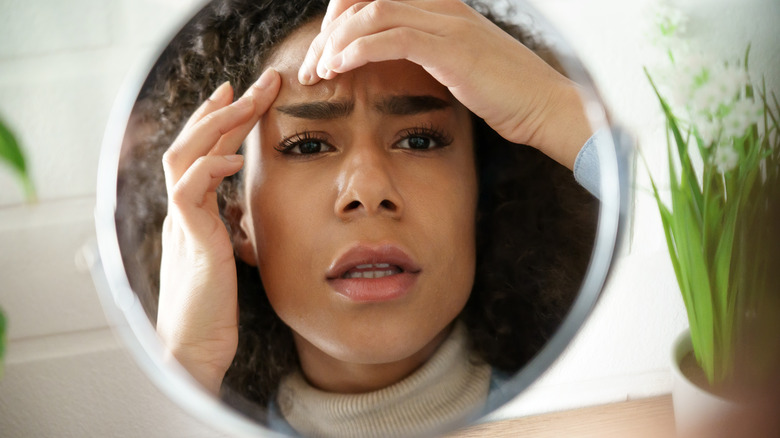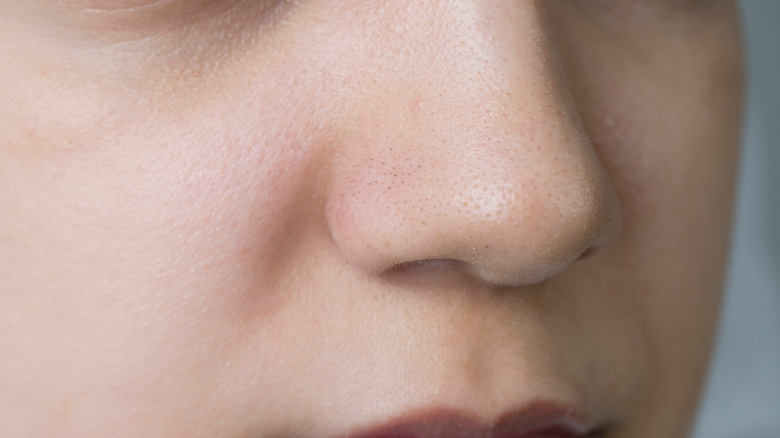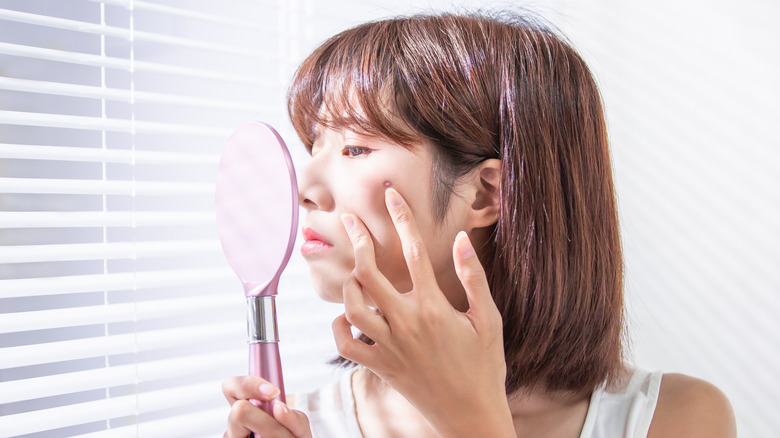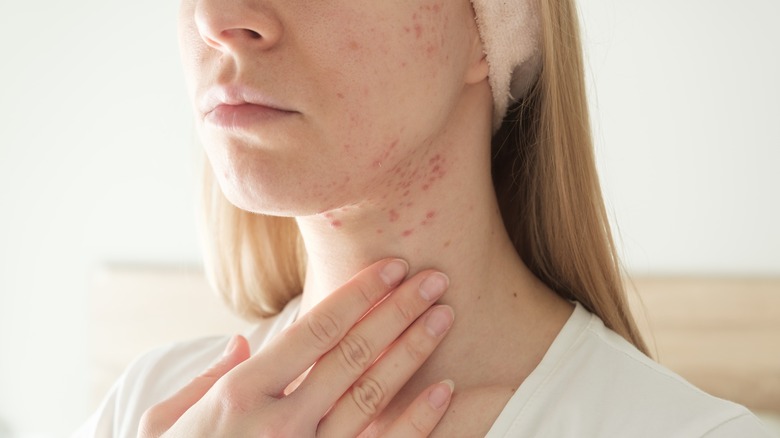Understanding Different Types Of Acne Breakouts (And The Best Ways To Treat Them)
Acne may be the only thing between you and a clear complexion, if only you could get rid of those lumps and bumps once and for all. Even if spots are frustrating to deal with, you're not alone in your struggles: According to a 2012 research review published in the British Journal of Dermatology, acne is one of the most common skin conditions, and the majority of people between the ages of 12 and 24 have some breakouts. Older adults can also get acne, with 43% of 30-something individuals still dealing with breakouts long after their days of spot-treating zits in high school are over.
Even if nearly everyone gets acne at one point or another, it shouldn't be brushed off. Skipping treatment can lead to worse breakouts, scarring, and low self-confidence, per the American Academy of Dermatology Association.
It's important to note, however, that treatment isn't one size fits all. "While most acne-prone people will benefit from over-the-counter (OTC) treatments, like benzoyl peroxide or salicylic acid cleansers and retinoids, the type and severity of your acne may influence whether other treatment options should be included in your regimen," Dr. Marisa Garshick, assistant clinical professor of dermatology at Cornell-New York Presbyterian Medical Center, explained to Self. Here's how to identify those pesky spots and the best course of action for each.
Whiteheads
A whitehead looks just as its name sounds: It's a raised blemish on the skin with a white (or sometimes yellow) head, covered by a layer of skin and oil. According to Healthline, these spots are known as closed comedones because the pore closes after becoming clogged, making them more challenging to treat than open pores.
Preventing these pesky bumps from forming requires first understanding their causes. Cleveland Clinic explains that excess sebum (the natural oil produced by your skin), bacteria, and the clumping together of keratin (the protein found in skin and hair) can trigger whiteheads. Surveying any changes in your lifestyle or hygiene habits could point to the cause of these issues. Over-the-counter skincare products can also treat whiteheads. Look for cleansers and ointments containing salicylic acid, azelaic acid, benzoyl peroxide, or retinoids. If non-prescription remedies don't help, see a doctor or dermatologist for a stronger solution.
Because whiteheads form just under the surface of the skin, they can be one of the most tempting types of acne to pick and pop. But should you? As dermatologist Dr. Joshua Zeichner told Insider, extracting acne isn't always a bad thing and can even be necessary when spots just won't go away. However, only a dermatologist or facialist should pop whiteheads.
Blackheads
Blackheads are similar to whiteheads in that they're both types of noninflammatory acne. With blackheads, however, the top of the pore remains open, unlike closed-off whiteheads. Then, rather than looking white or yellow in color, they can be spotted by a characteristic black dot on the skin. "Blackheads are just an oxidized mix of oil and dead skin cells that are sitting in pores, [and] the exposure to air is what causes them to oxidize and turn black," Dr. Rachel Nazarian, a board-certified dermatologist with Schweiger Dermatology Group in New York City, noted to Allure.
Blackheads have many of the same causes as whiteheads and can show up anywhere on the body where you have oil glands and hair follicles, per Cleveland Clinic. The most common locations for this type of acne to form include the nose, cheeks, chin, neck, back, and chest.
If you've noticed these dark blemishes on your skin, your first line of defense should be salicylic acid, according to Healthline. This ingredient can be a little harsh at first, so work it into your skincare regimen by using a salicylic cleanser once daily. Then, bump it up to twice a day. Besides treating existing blackheads, salicylic acid also exfoliates the skin to prevent new ones from forming. If you don't see an improvement within a few weeks, visit your dermatologist.
Papules
If your acne breakouts consist of small, red bumps, you're likely dealing with papules. These spots can be annoying, but they're still considered to be only a mild form of acne, per Medical News Today. Papules are raised spots without a light or dark head — instead, the spot and surrounding skin are shades of pink, red, or purple. These blemishes can feel tender when touched, but they shouldn't cause much discomfort. If you notice severe pain or swelling, you might have a nodule rather than a papule, according to Healthline. Nodular acne is rooted deep in the skin and requires a dermatologist to treat it.
Papules may be caused by bacteria, sebum, hormonal changes, and certain lifestyle factors (such as stress and consuming a poor diet). They often linger for a few days before turning into pustules. For either type of bump, it's best to avoid picking at the skin to avoid irritation or scarring.
To get a handle on papular acne breakouts, the American Academy of Dermatology Association suggests washing twice a day with a benzoyl peroxide or salicylic acid cleanser. If you notice several spots or spots that don't go away, see a doctor, who may prescribe topical medications, antibiotics, or a medication to balance hormones, such as birth control pills or spironolactone.
Pustules
Pustules are inflamed acne blemishes with a white or yellow center. While they may sound a lot like whiteheads, they're not the same thing. Medical News Today explains that pustules form differently than whiteheads and tend to be larger in size. Like whiteheads and other types of acne, though, pustules contain a combination of oil, bacteria, and dead skin cells.
When treating pustular acne, it's important to make sure that it's actually acne. Pustules can also result from allergic reactions, infections, and bug bites, notes Healthline. No matter their cause, never pop pustule blemishes — you might make them worse by doing so.
If you're sure the pimple is acne-related, try using skincare products with benzoyl peroxide or salicylic acid to tackle acne-causing bacteria and slough away dead skin cells. Pimple patches work to help manage these pus-filled bumps. "Pimple patches work by absorbing any drainage from the pimple and covering the wound to prevent further trauma to the site, such as picking," Dr. Amy Kassouf, a dermatologist, shared with Cleveland Clinic. "They work best on open, draining, healing pustules, papules, and cysts." See your dermatologist if these fixes don't keep pustules at bay.
Nodules and cysts
Nodular and cystic acne are the most severe types of breakouts and form when pores are clogged deep within the skin. Nodules occur when the clogged pore becomes infected, creating a hard and inflamed bump. Cysts are similar, though they're deeper than nodules, making them the most severe and damaging type of acne.
Nodular and cystic blemishes can have many of the same causes as other types of acne and result from sebum, bacteria, and dead skin cells becoming trapped in the pores. However, these spots often require a lot more than a new face wash to treat. "These bumps are often caused when there is a hormonal imbalance or during periods of stress, when your body responds by producing more cortisol," Dr. Dendy Engelman, a board-certified dermatologic surgeon at Medical Dermatology and Cosmetic Surgery in New York City, told Self. "Both hormones overstimulate the sebaceous oil glands, making your body produce more oil that gets stuck in your pores, thus trapping bacteria."
Besides practicing self-care to lower your stress levels, you'll likely need treatment from a doctor to prevent and get rid of nodules and cysts. If your doctor determines that hormones are the culprit, they may suggest you go on the pill. Isotretinoin, antibiotics, and steroid injections are other common options for dealing with these severe bumps.
